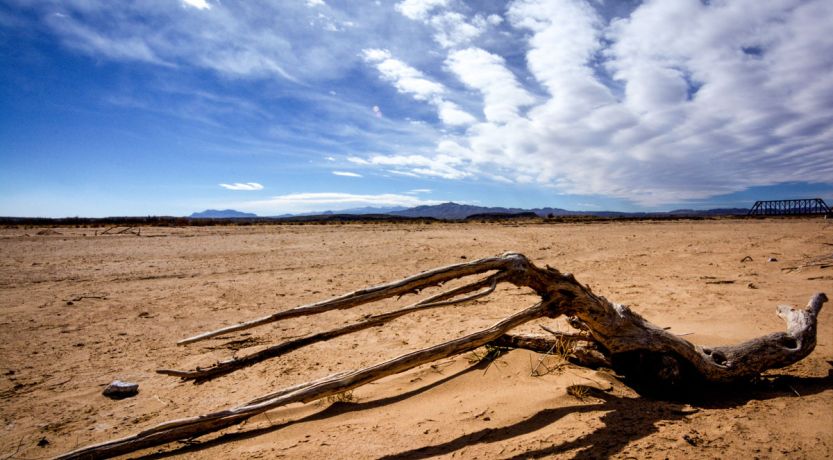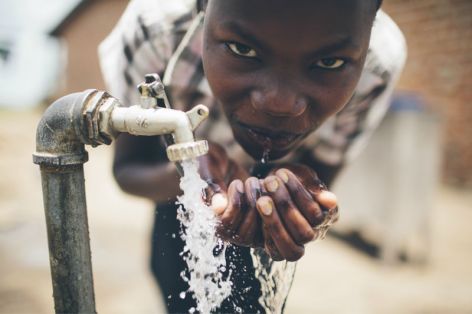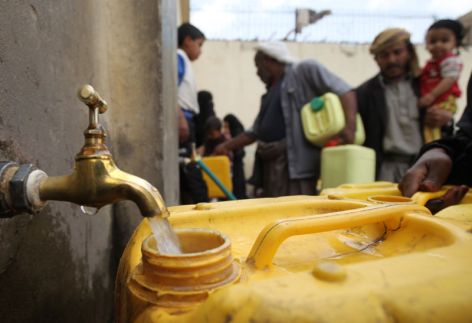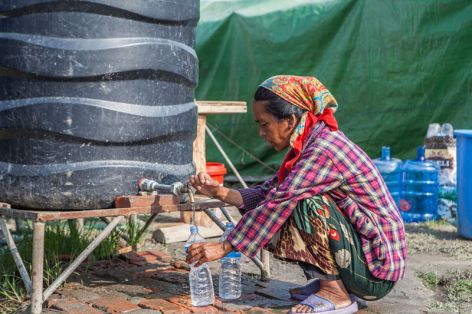What is happening to our water supplies? Will shortages affect our health, economy and lead to conflict? What does the Bible say about a future water crisis?

Water is a basic necessity for life.
Unfortunately, freshwater resources are dwindling rapidly. The world today is experiencing a surge of water-related crises, as reservoirs dry up and lake levels drop to historic lows.
Recent news about the water crisis (this section updated 2022)
Europe’s rivers fall to critical levels
According to The Wall Street Journal, “scorching temperatures have drained some of Europe’s main rivers, threatening to disrupt vital economic thoroughfares and exacerbate the continent’s energy shortage.
“In Germany, the Rhine is at critically low levels, hampering deliveries of coal and industrial goods, and is forecast to potentially become impassable for most barges at a key stretch by the end of the week.
“In France, the Rhône and Garonne have been too warm to cool nuclear reactors, leading to lower output. In Eastern Europe, Danube levels are dwindling, impeding a key Ukrainian grain route.
“While Europe’s rivers have increasingly suffered dry spells in recent years—which scientists say will become more common because of the warming climate—this year’s crisis comes as the continent struggles with reduced gas deliveries from Russia. The German government has decided to restart coal plants to alleviate the crunch, a task now complicated by river disruptions” (“Europe’s Key Rivers Fall to Critical Levels, Aggravating Energy Crunch,” Aug. 11, 2022).
Megadrought and the Colorado River
Two huge reservoirs on the Colorado River—Lake Mead (the largest artificial body of water in the U.S.) and Lake Powell (the second largest)—provide water and electricity to 40 million people in Nevada, Arizona, California, Wyoming, Colorado, New Mexico, and Mexico, as well as irrigation water for agriculture. But due to long-term drought, these reservoirs are now at their lowest levels ever and approaching “dead pool status,” when the water can no longer flow downstream.
“The conditions in the American west, which we’re seeing around the Colorado River basin, have been so dry for more than 20 years that we’re no longer speaking of a drought . . . We refer to it as ‘aridification’—a new very dry normal” (United Nations News).
“The searing ‘megadrought’ that has gripped the southwest U.S. for more than two decades is the driest 22-year period in at least 1,200 years. The region hasn’t seen a more severe drought since the start of the scientific record around the year 800” (Scientific American, Feb. 15, 2022).
Conditions in many areas are even worse than when the material below was published in 2015. But the causes, problems and solutions remain the same.
Effects of water scarcity
At least half of the 50,000 rivers that existed in China in the 1990s have disappeared, the water drained for use by factories and farms. At the time of writing, Pakistan’s emergency water reserves are down to a 30-day supply—a far cry from the recommended 1,000 days for semiarid countries. In the summer of 2014, the eastern basin of the Aral Sea dried up completely—the first time in 600 years.
Use of the Jordan River is drying up the Dead Sea, and now thousands of sinkholes dot its banks. The drought was so serious in southeastern Brazil, residents drilled through their floors to try to reach water, and schools discouraged students from using water to brush their teeth.
Those are just a few examples. According to the United Nations World Water Development Report 2015, about 1.2 billion people, or almost one-fifth of the world’s population, live in areas of physical water scarcity (meaning there isn’t enough water to meet demand). Another 1.6 billion people, or almost one quarter of the world’s population, face economic water shortage (a lack of infrastructure to use available water).
The Middle East is the most water-impoverished region. Shortages have also long plagued much of northern and sub-Saharan Africa, either due to dry conditions, economic water shortages or both. Increasingly, many Western nations are now feeling the heat.
A farm employee in northern Uganda drinks from a well.
As I write this, California is in the fourth year of an unprecedented drought, and groundwater and snowpack levels are at all-time lows. Poor land management and drought have turned much of southern Spain into a virtual desert, with farmers battling each other for what little water is available. Queensland, Australia, is suffering its most widespread drought, and record numbers of livestock have had to be slaughtered.
“Water scarcity is not unique to developing countries,” says Zafar Adeel, director of the UN University Institute for Water, Environment and Health and former chair of UN Water. “In the U.S., because there are a significant amount of resources to help people overcome some of the challenges of water shortages, you may not feel that crunch as much as somebody in a developing country would. But the problem is really quite universal.”
The World Bank reports that 80 countries have serious water shortages. Besides the Middle East and Africa, the regions with the worst problems are southern Australia, western United States, Central Asia, southern India, Bangladesh, northern China and sections of South America and Mexico.
All the signs suggest that water shortages will worsen in the years ahead, unless drastic measures are taken.
Fuel shortages and damaged pipelines have disrupted major water supply networks across Yemen.
Admittedly, water covers a lot of the earth’s surface. However, only 2½ percent of it is freshwater.
“Of that, only about a third of the world’s freshwater is available for us to use. The rest is locked up in glaciers and ice caps, or is deep underground,” notes Andrew Maddocks, communications and outreach coordinator for the water program at the World Resources Institute. “It’s a minuscule percentage of the total amount of freshwater that’s either available as surface water or as ground water that’s shallow enough to be accessible.”
This is the water that’s so vital for life, yet running in short supply.
Global water crisis facts
So what’s behind the global water crisis?
Population growth and water scarcity
In the 20th century, the population went from 1.7 billion to 6.6 billion people. Yet the earth’s freshwater supply is finite.
Simply put, “if you have 100 gallons of water per person and the population doubles, now there’s only 50 gallons per person,” says Aaron Wolf, professor of geography at Oregon State University and director of the Transboundary Freshwater Dispute Database project. “With more people on the earth, there’s less water to go around.”
Today, 70 percent of the world’s available freshwater goes to agriculture. “As populations grow, that puts a bigger strain on water resources,” notes Maddocks. “Crops like corn, soybeans, barley and wheat are extremely water intensive. The more people there are, the greater the demand for those water-intensive crops and the more water that will be needed.”
The world’s population is growing by about 80 million a year, according to World Bank statistics, and is predicted to reach 9.5 billion by 2050. Most of the growth will be in cities, putting a huge strain on urban water supplies.
An estimated 93 percent of urban growth is in developing countries, the UN reports. The largest developing region, sub-Saharan Africa, is projected to double its urban population by 2030.
If we don’t act now, “this will not only tax out their already limited water supplies, but mean more slums and shanty towns and, along with that, increased water pollution,” warns Olcay Ünver, deputy director of the UN Food and Agriculture Organization, land and water division.
Increased demand for water
In addition, per person consumption of water doubled in the last century. This was due to the world becoming more affluent, says Ünver. “As more and more people come out of poverty, they eat more meals (e.g. three times instead of once or twice a day) and more meat (which requires more water to produce than vegetables or grains).”
A puddle is the new pool for a little girl in California.
The world’s “new middle class” is buying washing machines, dishwashers, showers, toilets, swimming pools, etc. They’re also buying more goods like clothing, electronics and automobiles, all of which require water for production.
All this has increased demand for energy. “Producing any kind of energy requires intake of water,” notes Adeel. It takes huge quantities of water to produce electricity from nuclear energy or fossil fuels. Extracting oil and natural gas from the ground with hydraulic fracturing techniques also requires large amounts of water.
Overextraction of groundwater
Faced with growing water shortages, governments have been increasingly tapping subterranean supplies of groundwater.
“We are drawing down these hidden, mostly nonrenewable groundwater supplies at unsustainable rates in the several dry regions globally, threatening our future,” warns Ünver. Aquifers are being overdrawn in the western and central United States, northern China, India, Pakistan, Bangladesh, Iran, Mexico and Europe.
The UN estimates that global groundwater withdrawals have tripled in the past 50 years. Maddocks says one of the big issues is that “in most places, it’s impossible to know exactly how much groundwater you have available. It’s like making withdrawals from a bank account without knowing the balance.” Meanwhile, water continues to be pumped out as if there’s an endless supply.
Adds Steven Downey, head of communications for Global Water Partnership: “It can take the hydrological cycle hundreds of years, in some cases thousands of years, to replenish aquifers. So, for all practical purposes, in those places where the aquifers are being drained, that water is gone for good.”
Poor management of water resources
Water is also being lost via poor distribution infrastructures. This is occurring in developing nations, as well as developed countries. The American Water Works Association estimates that 2 trillion gallons of water (one-sixth of the water treated in the U.S.) is lost each year.
“In the U.S. a lot of our major cities have sewer systems and water treatment systems that are over 100 years old or at least many decades old, and that leads to a lot of leakage, cracked and burst pipes, and other inefficiencies,” notes Maddocks. “That’s a small piece of the pie relative to agriculture and energy, but it’s still an issue.”
Inefficiencies in agricultural practices are a factor too. As much as 70 percent of water used by farmers never gets to crops and is lost through leaky irrigation channels, reports the International Water Management Institute (IWMI). More precise water delivery systems are needed to make irrigation more efficient, but many nations do not have the funds to make these upgrades.
Changing weather patterns
Clearly, there has been an increase in both the severity and frequency of extreme climate events in recent years, Downey adds. Droughts can obviously result in water shortages. But floods and severe storms can wreak havoc on water supplies as well.
“In many poor countries, their water infrastructure is weak. A large storm can wipe out earthen dams and water cisterns on rooftops,” he says. “Even in a rich country such as the United States, Hurricane Katrina was strong enough to destroy protective dikes.” Not only that, “in any country, the water from floods carries lots of contaminants which can end up in freshwater sources such as groundwater.”
Pollution and the water crisis
Industrial wastes, agricultural runoff and sewage discharges have aggravated the water crisis. “The problem is not just that we’re facing water shortages, but that we’re running out of clean water,” Wolf states.
About 40 percent of rivers and lakes in the U.S. are too polluted to support normal activities. Around 70 percent of China’s rivers and lakes are contaminated with industrial waste, and nearly 60 percent of its underground water is polluted.
In developing countries, an estimated 90 percent of wastewater is discharged into rivers and other waterways, with little or no treatment. Almost half of all European bodies of water have unsafe levels of chemical toxins. The list could go on.
The ramifications of the water crisis
These trends are certainly disconcerting. How will they affect us?
Health consequences of the water crisis
One of the most serious ramifications relates to health. “Particularly in the developing world, people often don’t have access to clean drinking water, so they use whatever is available, even if it’s dirty,” notes Wolf. He estimates that between 5 and 10 million people die every year of water-related illnesses.
If shortages worsen, there won’t be enough water to grow food. Growing numbers of people could be affected by malnutrition and hunger.
By 2030, as populations grow and demand for water increases, the IWMI predicts farmers will have about half as much freshwater available to grow their crops—paradoxically at a time when the world’s food needs will have increased by 50 percent.
Economic implications of the water crisis
Another concern relates to economic health. Water shortages can lead to energy shortages, which can have a domino effect, making it harder for businesses and industries to function. A case in point is the drought São Paulo, Brazil, faced in 2001-2002.
Explains Maddocks: “That drought led to a decline in reservoir levels and reduction in hydro power that was generated from water flowing through the dams, so energy capacity was cut. That resulted in nationwide blackouts and power rationing.”
In the end, it cost Brazil nearly 1.5 percent of its gross domestic product in 2001. “When water resources are unreliable, just about every sector of the economy is impacted.”
The potential for conflict over water
Third, water shortages may contribute to geopolitical conflict (see “Water Wars”).
Searching for water crisis solutions
A Nepalese earthquake survivor obtains water from a tank at a relief camp after already scarce water sources were contaminated by the disaster.
While there are certainly no quick fixes to water shortages, a number of technological options are available to help solve problems of both water quantity and quality. “The global community is profoundly aware of the water issue; and the technology [and] solutions are out there,” Wolf says. “It’s just a question of resources and political will.”
Since the majority of freshwater usage is allocated to agriculture, there has been a big push for farmers to use drip irrigation systems (which give crops the exact amount of water needed) and to plant saline- and drought-tolerant crops.
Other strategies include improving municipal water supply systems and repairing pipes to reduce leakage, rainwater harvesting, the reuse of treated wastewater for agriculture, desalination of seawater, expanding use of renewable energy sources like wind and solar power, and media campaigns to educate the public about water conservation.
Innovative technologies, such as waterless fracking, waterless toilets and more water-efficient washing machines may prove useful as well.
All people “must be more mindful about how much water they are consuming, and be more efficient in their water use,” Adeel says. “Governments must improve internal water policies that support efficiency and conservation. Countries need to negotiate such things as river alterations and shared groundwater usage, and not act unilaterally.”
Adeel believes the world needs to move quickly to avert a full-blown water crisis. “If we keep doing business as usual, our world will require 40 percent more water 20 years from now. But if we change our patterns of water usage, we could actually achieve a 40 percent reduction in usage,” he says. “Today, not tomorrow, is the time to start turning this situation around.”
To understand the deeper significance the Bible gives to this issue, be sure to read the accompanying article “Water in Bible Prophecy.”
Photo credit: Michael W. Wile/CC BY-NC-ND 4.0/derivative used with permission.




